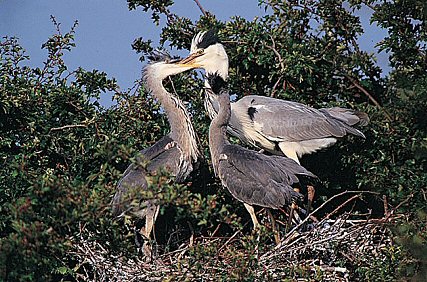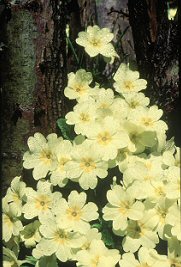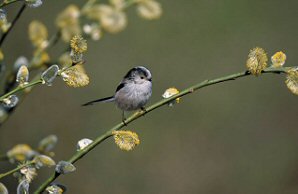Countryside Rangers Diary
March
Though winter often has a sting in its tail, we are now leaving the dreariest months of the year behind. Spring flowers are opening and butterflies are emerging from hibernation. Listen out for the first warblers, the rich bubbling of a black cap or the unmistakable song of a chiff-chaff. At last it's the start of the naturalist's new year.
- The early nesting Herons hatches their first brood.

- Squirrels start the year early, mating in January and February. By now the females are ready to give birth. They make special nursery dreys, either by refurbishing an ordinary one or building one from scratch. Dreys are easy to see at this time of year when the trees are still bare. A nursing mother won't travel very far from home in the first few weeks after giving birth. From their vantage points high up in the trees squirrels can spot movement from a considerable distance. The best way to watch them is to sit silently at the bottom of a tree near a drey and wait for the action to unfold.
 March is the month of Blackthorns, Prunus spinosa, white flowers. The bare bushes suddenly burst into frothy heaps of white flowers.
March is the month of Blackthorns, Prunus spinosa, white flowers. The bare bushes suddenly burst into frothy heaps of white flowers.- Its peak time for toads spawning, slightly later than frogs.
- First bumblebees and hoverflies are on the wing.
- Given a bit of warm air and some decent thermals sparrowhawks and buzzards become more conspicuous this month. On bright days you may be treated to a display flight involving high soaring and steep, repeated stooping flights.
- After a period of bright, warm weather adders (Britain's most common snake) will be emerging from hibernation. Look for them sunning themselves on south-facing banks where there are plenty of hiding holes nearby. Remember adders are protected by the Wildlife and Countryside Act. Look don't touch!
 The first Rose- The primrose gets its mane from its early appearance- the 'prima rosa' or first rose. The primrose must be among the most familiar signs of spring, but there is more to their pale lemon flowers than initially meets the eye. For a plant the whole point of flowering is to spread its genes via male pollen grains to the female parts of another plant of the same species. But when each plant produces more than one bloom the risk of self-pollination is high. Primroses get over this by the arrangement of the male and female parts. Look closely at the flowers from several plants and you will spot 2 distinct types, 'pin-eyed' and 'thrum-eyed'. The multiple blooms in a single plant are all the same. This ensures that a visiting insect will not be able to self pollinate the flowers, however, when it reaches a plant of the different type any pollen on its body will be in perfect alignment for fertilisation.
The first Rose- The primrose gets its mane from its early appearance- the 'prima rosa' or first rose. The primrose must be among the most familiar signs of spring, but there is more to their pale lemon flowers than initially meets the eye. For a plant the whole point of flowering is to spread its genes via male pollen grains to the female parts of another plant of the same species. But when each plant produces more than one bloom the risk of self-pollination is high. Primroses get over this by the arrangement of the male and female parts. Look closely at the flowers from several plants and you will spot 2 distinct types, 'pin-eyed' and 'thrum-eyed'. The multiple blooms in a single plant are all the same. This ensures that a visiting insect will not be able to self pollinate the flowers, however, when it reaches a plant of the different type any pollen on its body will be in perfect alignment for fertilisation.- Red and fallow deer cast their antlers
- Don't disturb the early birds!!-A cold spell this month may catch out many of our resident birds at the beginning of their breeding attempts. You may think that this would be a good reason for not trying to be the early bird but this is not so. The egg is a very efficient package. If it has not yet been incubated it can remain alive even when it has been severely chilled. Once incubation has started the female, which has excellent reserves of fat at the start of the breeding period should normally have a good chance of success.
- Spot the migrants -March often sees the first of the insect migrants. The red admiral and painted lady butterflies are well known, but others come too, blown up by the strong, crisp winds from central and southern Europe.
 Sort out your sallows-Towards the end of the month you won't be able to miss the catkins of pussy willow. This name applies to the goat willow, Salix caprea. It has male catkins, which are particularly big and showy, developing masses of bright yellow anthers. The grey willow, Salix cinerea, tends to have more narrow cylindrical catkins. Recognising the different species is no easy matter. If the specimen is a tall shrub or a small tree on the edge of woodland or in an old hedge and has big showy catkins it is likely to be a goat willow. Peel off the bark; if there are distinct, longitudinal ridges on the surface of the underlying wood then it is more likely to be grey sallow. Come back later in the year when the leaves are out, this will help you to confirm your identification.
Sort out your sallows-Towards the end of the month you won't be able to miss the catkins of pussy willow. This name applies to the goat willow, Salix caprea. It has male catkins, which are particularly big and showy, developing masses of bright yellow anthers. The grey willow, Salix cinerea, tends to have more narrow cylindrical catkins. Recognising the different species is no easy matter. If the specimen is a tall shrub or a small tree on the edge of woodland or in an old hedge and has big showy catkins it is likely to be a goat willow. Peel off the bark; if there are distinct, longitudinal ridges on the surface of the underlying wood then it is more likely to be grey sallow. Come back later in the year when the leaves are out, this will help you to confirm your identification.